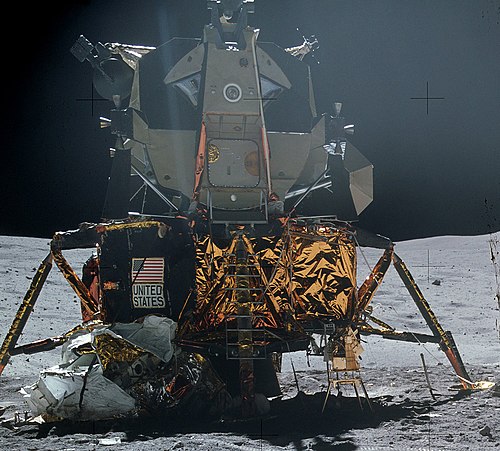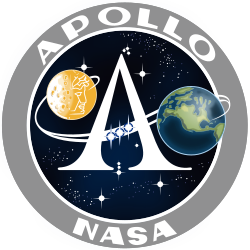Apollo Lunar Module
The Apollo Lunar Module (LM) is a spidery-looking lander that landed on the moon. It was built for the US Apollo program to carry a crew of two from lunar orbit to the surface and back.
 Apollo 16 LM Orion on the lunar surface | |
| Manufacturer | Grumman Aircraft |
|---|---|
| Designer | Thomas J. Kelly |
| Country of origin | United States |
| Operator | NASA |
| Applications | Manned lunar landing |
| Specifications | |
| Design life | 75 hours (Extended) |
| Launch mass |
|
| Dry mass |
|
| Crew capacity | 2 |
| Dimensions | 23 feet 1 inch (7.04 m) high 31 feet (9.4 m) wide 31 feet (9.4 m) deep overall, landing gear deployed |
| Volume | 235 cubic feet (6.7 m3) |
| Power | Batteries |
| Regime | Lunar |
| Production | |
| Status | Retired |
| Built | 15 |
| Launched | 10 |
| Operational | 10 |
| Failed | 0 |
| Lost | 0 |
| First launch | January 22, 1968 |
| Last launch | December 14, 1972 |
| Last retirement | December 15, 1972 |
  Apollo LM diagram | |
The LM was the last of the Apollo “hardware” to be developed. Its start had been delayed while NASA made up its mind to take the lunar-orbit meeting approach and thus require a vehicle like the LM for a landing. A contract with the prime builder was signed on January, 1963, almost two years after the Apollo project began. The LM was tested several times in space.[1] Finally, on July 20, 1969 the Apollo 11 LM Eagle made the first manned lunar landing.
As Apollo missions progressed, Apollo 12, 14, 15, 16, 17 had lunar landings using their LMs. Apollo 13 had a terribly dangerous accident when an oxygen tank exploded. The Apollo 13 Lunar module, called Aquarius, played an unexpected role in saving the lives of the three astronauts after the explosion.[2]
Specifications
The LM was consisted of an ascent stage and decent stage.
Descent stage
This was the unmanned lower part of the LM. it looked like octagonal-shaped. It was made of aluminum alloy and had four legs for landing. It had a descent rocket engine, and batteries and various supplies and scientific equipment to be used when landing on the moon and during the astronauts’ stay on the moon.
To land on the moon, the descent engine would be fired to begin the LM’s drop from 110 kilometres (68 miles) out in lunar orbit down toward the moon. LM could descend vertically and hover above the surface of moon. After the two men finished their stay on the surface, the ascent stage, sitting on the descent stage, would use its ascent engine firing to lift itself off the moon.
Ascent stage
This was the roundish upper half of the LM, the command center and crew cabin as well as the launching rocket for leaving the moon.
To save weight, there were no seats for the men. They would stand, loosely held in place by straps. In front and on either side of them were control panels for the LM’s guidance, communication, environment and propulsion systems. On the left side, there was a window by which commander could look out to steer the LM. Overhead in the middle section was the 90 centimetres (35 inches) of diameter hatch where the astronauts transferred to and from the Command Module when two vehicles were linked. LM’s ascent rocket to meet Command Module was below the deck of the midsection. Although ascent rocket was small, it was sufficient because the moon’s weak gravity – one-sixth that of earth’s – meant that the LM would not require a strong push to rise from the lunar surface.
First flight of Lunar Module
On Monday, January 22, 1968, a 16-ton unmanned Lunar Module surrounded by a protective shield stood on top of a two-stage Saturn 1-B rocket called Apollo 5. This flight was made to do two important tests. One was to check separating stage from main rocket. The second was to check test firing of the descent engine, but this mission did not succeed. The Apollo 5 test ended after eight hours, and the LM remained in earth orbit. It eventually dropped into the atmosphere and burned up.
Apollo Lunar Module Media
Lunar Module Eagle, the Lunar Module ascent stage of Apollo 11, in orbit above the Moon. Earth is visible in the distance. Photograph by Michael Collins aboard the Command module Columbia.
A 1962 model of the first LEM design, docked to the command and service module. The model is held by Joseph Shea, the key engineer behind the adoption of lunar orbit rendezvous mission logistics.
Lunar Landing Research Vehicle (LLRV) during a test flight
The Apollo 11 Lunar Module Eagle in lunar orbit
Decreased clearance led to buckling of the extended descent engine nozzle on the landing of Apollo 15.
Lunar ascent by Apollo 17 ascent stage
Neil Armstrong lands the Apollo 11 Lunar Module Eagle on the Moon, July 20, 1969, creating Tranquility Base. Starts approximately 6200 feet from the surface.
David Scott lands Apollo 15 Lunar Module Falcon on the Moon on July 30, 1971, seen from the perspective of the Lunar Module Pilot. Starts at approximately 5000 feet from the surface.
Apollo 15 Lunar Module Falcon lifts off from the Moon, August 2, 1971. View from TV camera on the Lunar Roving Vehicle.
Apollo 15 Lunar Module liftoff. View from inside Falcon.
Apollo 17 Lunar Module Challenger liftoffs from the Moon on December 14, 1972. View from TV camera on the Lunar Roving Vehicle.
Related pages
References
- ↑ Moon Race: The History of Apollo DVD, Columbia River Entertainment (Portland, Oregon, 2007)
- ↑ Cass, Stephen (April 1, 2005). "Houston, we have a solution". IEEE. Retrieved August 30, 2019.
Other websites
| Wikimedia Commons has media related to Lua error in Module:Commons_link at line 62: attempt to index field 'wikibase' (a nil value).. |
- 50 Years Ago: The Apollo Lunar Module
- Google Moon overview of Apollo landing sites
- NASA catalog: Apollo 14 Lunar Module
- Demonstration of the Lunar Excursion Module and explanation of its systems
- Space/Craft Assembly & Test Remembered
- We Called It 'The Bug' Archived 2010-12-25 at the Wayback Machine,
- Apollo 11 LM Structures handout for LM-5 (PDF)
- Apollo Operations Handbook, Lunar Module (LM 10 and Subsequent), Volume One. Subsystems Data (PDF)
- Apollo Operations Handbook, Lunar Module (LM 11 and Subsequent), Volume Two. Operational Procedures
- Apollo 15 LM Activation Checklist for LM-10 Archived 2013-03-02 at the Wayback Machine
- Lunar module launch Archived 2011-09-28 at the Wayback Machine video









